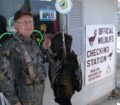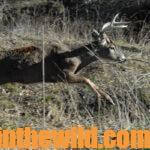Editor’s Note: The one thing I know for certain is that the only people who don’t miss turkeys are the people who don’t hunt them. Regardless of how well you shoot, how close you let the turkeys get, what type of gun and ammunition you use and how many years you’ve been hunting, you’re still going to miss turkeys. Turkeys have an uncanny ability to dodge shots. I don’t know how they do it; they just do. This week we’re looking at reasons why I’ve missed turkeys. Most hunters probably won’t tell on themselves. However, I know that the turkey hunters who read this article will appreciate my honesty and perhaps learn from my mistakes.
 1. Have confidence in your shooting ability. To know what will happen when you squeeze the trigger on your shotgun, pattern your gun at distances of 10 to 40 yards before you go into the woods to hunt. Once you understand how the gun patterns at varying distances, then you’ll have the confidence you need in your equipment to down a tom when he is within range.
1. Have confidence in your shooting ability. To know what will happen when you squeeze the trigger on your shotgun, pattern your gun at distances of 10 to 40 yards before you go into the woods to hunt. Once you understand how the gun patterns at varying distances, then you’ll have the confidence you need in your equipment to down a tom when he is within range.
2. Learn to judge distance accurately. If you’re not sure how far a turkey is from you in the woods, then you don’t know whether he is in the range of your shotgun or not. Estimating distances you are from an object in the woods and then stepping off that distance will help you learn to judge distance more effectively.
3. Concentrate not only on the tom turkey as he approaches but also on the bead of your shotgun. You must be able to see that bead as well as the turkey to shoot accurately. Often a turkey hunter who watches a gobbler move within range never sees the bead on his shotgun when he pulls the trigger.
4. Know where to place the shot. If you aim for the turkey’s head and neck, you’ll bring the bird down much more efficiently. By aiming at the gobbler’s wattles, the largest part of your pattern usually will cover the kill zone.
5. Have patience. Oftentimes you’ll miss a turkey because you try to rush a shot and take it too quickly. Wait on the turkey to present a good, clean shot, or else don’t shoot.
 6. Sit in a comfortable shooting position. If you’re not comfortable, and you can’t sit motionless for an extended time, you may begin to fidget or shake as your muscles cramp, perhaps just as you take the shot. Then you may miss.
6. Sit in a comfortable shooting position. If you’re not comfortable, and you can’t sit motionless for an extended time, you may begin to fidget or shake as your muscles cramp, perhaps just as you take the shot. Then you may miss.
7. Position your gun where you can take the shot. If you shoot right-handed, quarter slightly to the right. You want to face slightly to the right of the turkey you’ve called in to where you are. Then you’ll have at least 180-degrees you can turn and get off a shot. If you’re a left-handed shooter, quarter slightly to your left for the same reason. Never sit facing straightaway to a turkey.
8. Use a quality insect repellent. If you have a tick crawling up your leg, a mosquito buzzing in your ear or a deerfly stinging, you’ll find concentrating on the shot difficult. Insect repellent keep bugs from biting you and insects from distracting you when you’re trying to take a turkey.
9. Develop confidence in your calling skills. If you know you can call a wild turkey, then you won’t be nervous when you have to make calls, and the bird is in close. If you don’t believe you can call a turkey, this lack of confidence may cause you to miss the bird when he is in close.
 10. Wear camouflage you’re convinced works the best at hiding you in the area where you hunt. If you’re covered up with camouflage clothing from head to toe, and you know the turkey can’t see you, then you won’t be as afraid to move when you must. You’ll also be willing to let a bird get in close enough for you to take a good shot without feeling you have to rush the shot before the turkey spots you.”
10. Wear camouflage you’re convinced works the best at hiding you in the area where you hunt. If you’re covered up with camouflage clothing from head to toe, and you know the turkey can’t see you, then you won’t be as afraid to move when you must. You’ll also be willing to let a bird get in close enough for you to take a good shot without feeling you have to rush the shot before the turkey spots you.”
To learn more about turkey hunting, check out John E. Phillips’ print, Audible and Kindle turkey books at https://johninthewild.com/books/#turkey. For a free copy of John E. Phillips’ “The Turkey Gobbler Getter Manual,” go to https://johninthewild.com/free-books/.










